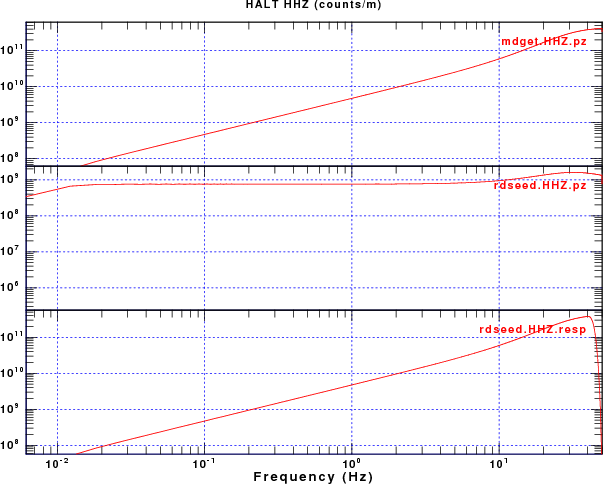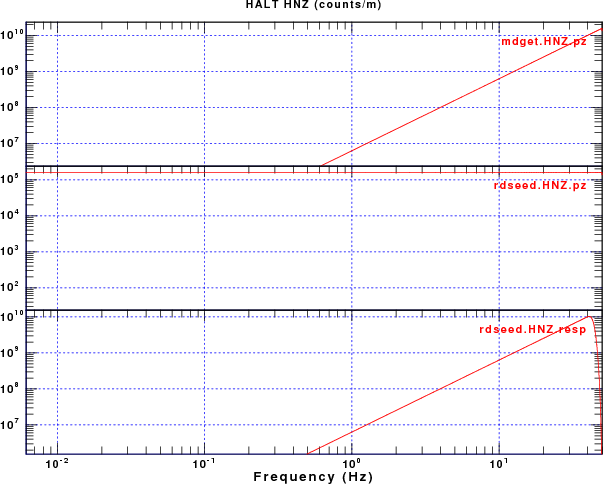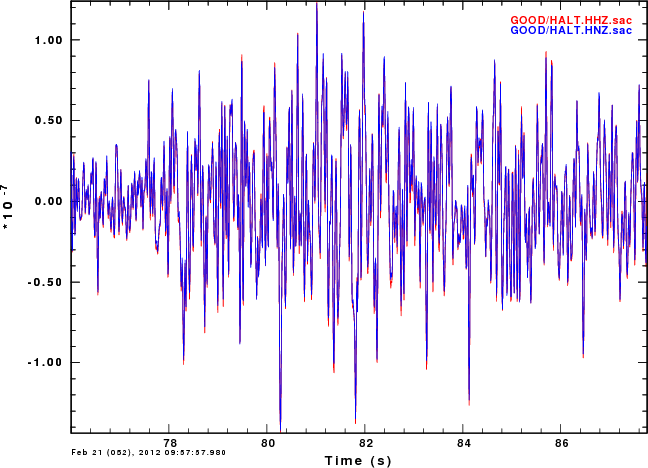After an analysis of the SLU stations, I decided to look at the CERI stations. I applied the following steps:
mdget -s NM.......... -dataless
mdget -s NMHALT.HHZ.. -b 2012/02/21-00:00:00 -d 180 -sac > HALT.HHZ.pz mdget -s NMHALT.HNZ.. -b 2012/02/21-00:00:00 -d 180 -sac > HALT.HNZ.pz
rdseed -f CERI.all.seed -p -Rwhere the -p flag indicates that Sac polezero files should be created and the -R indicates that the RESP file should be created. The RESP file is used with evalresp and contains the complete system specification including sensor, analog filters, analog-to-digical conversion and digital filters.
The SLU moodification of rdseed outputs extra information as the RESP files are created. Focusing on the HALT HHZ and HNZ channels, the following error messages appear:
Setting the number of zeros to add to 0 Warning - couldn't find the abbrevation for the signal units code! Signal units code =0 For station: HALT; channel: HHZ Setting the number of zeros to add to 0 Warning - couldn't find the abbrevation for the signal units code! Signal units code =0 For station: HALT; channel: HNZwhich indicates that something is not up to standard.
In the comparisons that follow, displacement sensitivities are computed using the polezero file, mdget.HHZ.pz obtained using mdget, the polezero file rdseed.HHZ.pz obtained using rdseed and the RESP file, rdseed.HHZ.resp obtained using rdseed and evalresp which gives the amplitude and phase resposne as a fucntion of frequency. This was also done for the accelerometer channel, HNZ.
All output plots are for COUNTS output and METERS input.
The mdget.HHZ.pz was adjust for the fact that mdget returned the response in terms of COUTS output for micrometer (UM) input.
The plots below compare the responses.


The major problem is that the polezero file obtained using rdseed is actually the velocity sensitivity for the HHZ channel and the acceleration sensitivity for the HNZ channel, which is seen by the equivalence of the responses at a frequency of 0.16 Hz (ω = 1 ). This may be related to the rdseed error message indicated above.
The mdget.HHZ.pz files is appropriate for an accelerometer since the displacement sensitivity varies at high frequency as f 1.
The mdget.HNZ.pz files is appropriate for an accelerometer since the displacement sensitivity varies at high frequency as f 2.

The agreement is excellent.